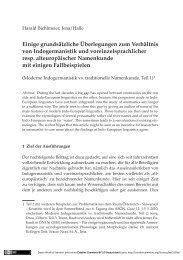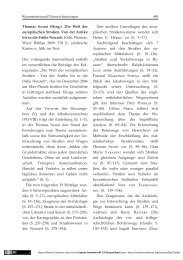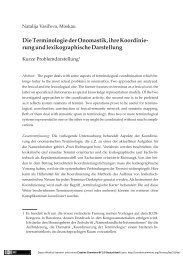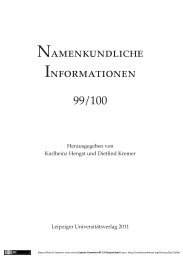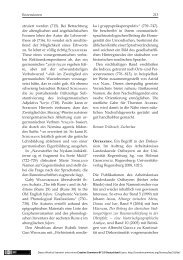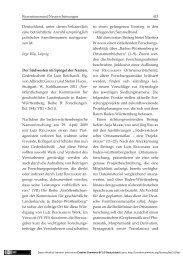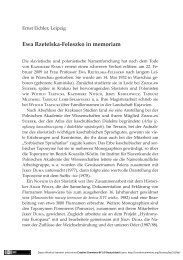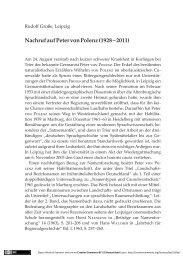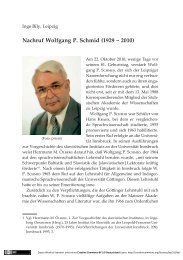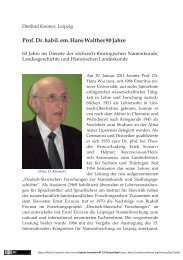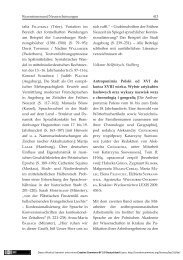Proper Names in the Light of Theoretical Onomastics
Proper Names in the Light of Theoretical Onomastics
Proper Names in the Light of Theoretical Onomastics
Create successful ePaper yourself
Turn your PDF publications into a flip-book with our unique Google optimized e-Paper software.
<strong>Proper</strong> <strong>Names</strong> In <strong>the</strong> <strong>Light</strong> <strong>of</strong> <strong>Theoretical</strong> <strong>Onomastics</strong>107formal aspect <strong>of</strong> an onymic sign <strong>in</strong> a given subsystem and <strong>in</strong> <strong>the</strong> socialand communicational conditions established. Here I analyse <strong>the</strong> situation<strong>in</strong> <strong>the</strong> Slovak language.Features <strong>of</strong> grammatical character1. A general feature <strong>of</strong> propria which has a functional and <strong>in</strong>tegrationalcharacter 〈socially determ<strong>in</strong>ed identification // differentiation with<strong>in</strong> agiven class〉 is applied <strong>in</strong> proprial nom<strong>in</strong>ation to <strong>the</strong> proper name as an<strong>in</strong>dependently exist<strong>in</strong>g entity. Any language form is substantiated <strong>in</strong> <strong>the</strong>validity <strong>of</strong> <strong>the</strong> proper name. As far as <strong>the</strong> language structure is concerned,<strong>the</strong>re are sets <strong>of</strong> proper names which are richly varied: compare personalnames Krátky-Short, Zlejší-Worse, Mlkvik-Quiet, Nesvadba, Ozembuch, an -oi ko nyms Pri pieskoch By Sands, Medzi potoky-Between Streams, chrematonymsKadernícky salón Katka-Hairdressers’Katka, a novel Komu zvonia do hrobu-ForWhom The Bell Tolls, logonyms A + B, TIP-TOP. The <strong>in</strong>ventory <strong>of</strong>names extends <strong>in</strong> respect <strong>of</strong> various situations <strong>of</strong> nam<strong>in</strong>g by <strong>the</strong> selection<strong>of</strong> lexemes (which <strong>in</strong> appellative form <strong>of</strong>ten do not have pendants) andalso by less common word-form<strong>in</strong>g procedures (Blanár 1950, 1996, 2005and elsewhere). Let us cite, for example, <strong>the</strong> revaluation <strong>of</strong> <strong>the</strong> des<strong>in</strong>entialmorphemes to <strong>the</strong> derivational morphemes <strong>in</strong> <strong>the</strong> process <strong>of</strong> <strong>the</strong> substantiation<strong>of</strong> grammatical forms: Oberaj, -a, -ovi; Zapletal, -a, -ovi…, Tomašových,-a, -ovi…, Nebojsa, -u, -ovi…; <strong>the</strong> univerbalisation <strong>of</strong> comb<strong>in</strong>ations <strong>of</strong> words:Starigazda, Zátroch, Zedvora; <strong>the</strong> existence <strong>of</strong> variations <strong>of</strong> prepositionalanoikonyms allows for <strong>the</strong> creation <strong>of</strong> a complete paradigm: Pri pieskoch –By Sands // Piesky-Sands, Medzi potoky-Between Streams // Potoky-Streams. Acharacteristic feature <strong>of</strong> proper names is <strong>the</strong> specific usage <strong>of</strong> <strong>the</strong> category<strong>of</strong> gender, number and case when <strong>the</strong> proper name becomes part <strong>of</strong> anoral or written text. Several examples <strong>of</strong> <strong>the</strong> category <strong>of</strong> gender follow.Personal names have natural gender. The category <strong>of</strong> gender <strong>of</strong> mascul<strong>in</strong>eliv<strong>in</strong>g propria is one <strong>of</strong> <strong>the</strong> most active factors <strong>in</strong> <strong>the</strong> decl<strong>in</strong>ation <strong>of</strong> propernames which <strong>in</strong> onymisation determ<strong>in</strong>es <strong>in</strong>ter-paradigmatic shifts <strong>of</strong> extensiveparts <strong>of</strong> lexis. In <strong>the</strong> process <strong>of</strong> onymisation, paradigmatic reconstructionaffects mascul<strong>in</strong>e <strong>in</strong>animate, fem<strong>in</strong><strong>in</strong>e and neuter nouns. A characteristicprocedure is an <strong>in</strong>ternal l<strong>in</strong>gual solution <strong>of</strong> <strong>the</strong> discrepanciesbet ween <strong>the</strong> natural gender <strong>of</strong> a motivat<strong>in</strong>g member (mascul<strong>in</strong>e person)and a motivated word which does not belong to <strong>the</strong> class <strong>of</strong> mascul<strong>in</strong>epersons, e. g. hlava (head) % surname Hlava, hruška (pear) % surname Hrušk a,



